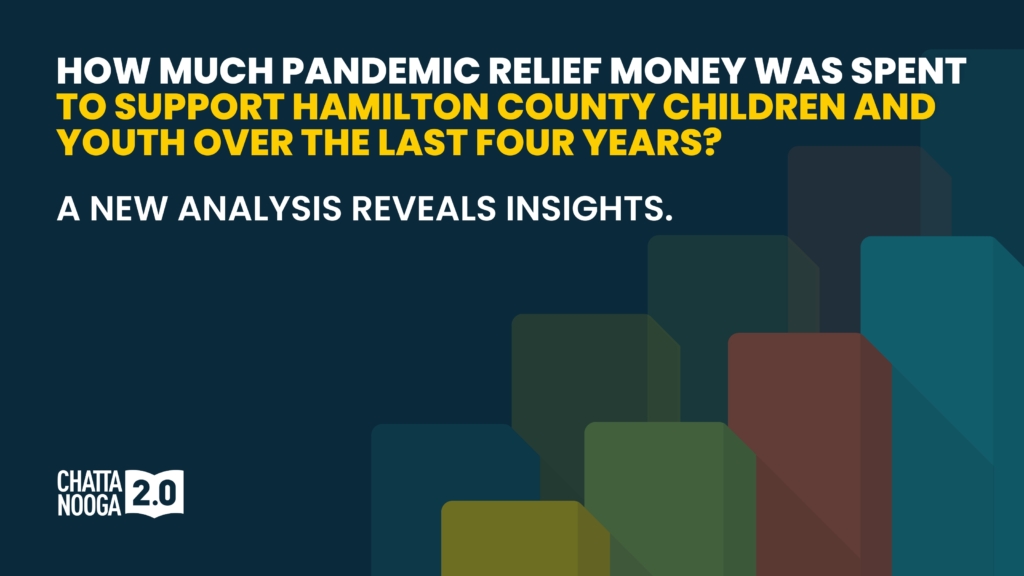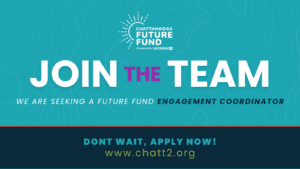By Rachel Kramer, Director of Data Strategy Impact
The Chattanooga 2.0 backbone team is excited to release the first-of-its-kind fiscal map analysis for public spending in Hamilton County that benefits children and youth. Not sure what that means? Let’s dig in.
What is a fiscal map?
A fiscal map documents and analyzes the various sources of funding supporting programs and services for children and youth. These maps can include public dollars from federal, state, and local sources, as well as private dollars from foundations and other philanthropies. They answer a fundamental question: who invests how much money and in what?
What is included on the federal relief funding fiscal map?
The fiscal map we released today includes all federal COVID-19 relief funds received by Hamilton County and the City of Chattanooga for programs and services supporting children and youth. From 2020 to 2024, the total amount of relief dollars received to serve children and youth in Hamilton County was $344 million.
On page 1 of the dashboard, you will find an overview of all the federal relief funding received from fiscal year (FY) 2020 to FY2024 categorized by eligible services and programs. You can explore each funding stream name, a short description, and available funds by year.
Pages 2 and 3 provide a look into Elementary and Secondary Education Emergency Relief (ESSER) funds that the Hamilton County Department of Education received. Page 2 gives a broad view of how much was spent each year while page 3 looks more closely at what the dollars were spent on (such as summer learning and afterschool programs).
What can this fiscal map be used for?
This fiscal map can be used to better understand public spending of COVID-19 federal relief dollars on children and youth programs across Hamilton County. Leaders and advocates can use this map to identify the existing funding streams supporting children and youth and which programs may lose funding as we approach the end of these relief funds.
What are the key takeaways?
From FY2020 to FY2024, Hamilton County received a total of $333 million in relief dollars to serve children and youth. These grants are multi-year, allowing unspent funds to roll over to the following year, contributing to the total available funding each year. The Hamilton County school district was allocated $142 million of Elementary and Secondary Education Emergency Relief (ESSER) funding to address the challenges and impact of the COVID-19 pandemic. As of summer 2024, these funds have been spent or encumbered, with plans to expend any remaining funds by the end of 2024. These dollars supported programs and initiatives such as addressing learning loss, providing mental health support for staff, and employing school social workers. Additionally, approximately $65 million in COVID-19 relief funds were directed toward early childhood services, including keeping vital childcare businesses open to maintain existing early childhood education seats and expanding the early childhood education workforce. However, with the end of this funding, some programs serving children and youth in Hamilton County may close or reduce their capacity due to significant loss of funding
What will children and youth lose as relief funding comes to an end this December?
In early childhood, the end of relief funding could mean:
- Child care providers no longer have the safety net of annual operational and staff retention grants to keep their doors open. In 2024, the Department of Human Services used a separate funding stream for the most recent staff retention grant; however, there is no guarantee that these funds will continue.
- High-quality childcare is a two-generational benefit–good for the economic stability of the young family and good for the cognitive and social development of the child. Losing any child-care seats due to lack of public investment will have a negative impact on working families’ ability to stay in the workforce.
In the out-of-school-time sector, the end of relief funding could mean:
- A potential decrease in the number of available afterschool and summer programming opportunities for Hamilton County school-aged youth. Afterschool programs are crucial to promoting positive youth development and bring many benefits to the community such as academic support and providing a safe space while parents are at work.
For elementary school-aged children, the end of relief funding could mean:
- A potential decrease in supports to help address learning loss. Hamilton County Schools has done a very good job of anticipating the end of ESSER funds and strategically budgeted to ensure there is no negative impact on students. However, students are still behind academically and the need for ongoing tutoring and summer learning remains. Additional funds will be needed to continue running these programs.
- Additionally, the district has used ESSER funds to hire additional staff that have been crucial to ensuring the success of the Hamilton County Schools. The district will need to source additional funding to ensure these positions remain.
For students pursuing a postsecondary education, the end of relief funding could mean:
- A decrease in financial aid for students that covered not just tuition but also food, housing, health care, or childcare. Research has shown that HEERF funds ensured that students who had a high risk of dropping out were able to stay enrolled. These emergency funds enabled students to graduate and enter the workforce.
A fiscal map allows our community to analyze investments from a child- and youth-centered perspective and reflect on what we want for our kids and our community. Remember- what gets budgeted gets done.
This blog is the first in a series on children’s funding and Chattanooga 2.0’s fiscal map analyses.
Chattanooga 2.0 would like to thank Children’s Funding Project for its assistance developing the Hamilton County fiscal map. For questions, please contact Rachel Kramer, rachel@chatt2.org For media inquiries, please contact Keri Randolph, keri@chatt2.org





